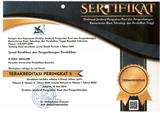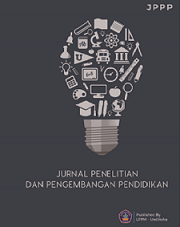Digital Tales Media to Improve Reading Literacy for II Grade Elementary School Students
DOI:
https://doi.org/10.23887/jppp.v7i1.59886Keywords:
Development, Digital Fairy Tale Media, Elementary SchoolAbstract
The problem occurs in the learning process, where elementary school students are less motivated to understand material in the form of stories without pictures. Therefore, the researcher conducts this study to develop digital fairy tale media that is applied to second grade of elementary school students. This research is a type of research and development (R&D) or research and development according to Bord and Gall. The steps taken in this research and development, namely: research and data collection, planning, initial product development, initial field trials, revision of trial results, field trials, product enhancements that have been refined, field implementation trials, product improvement final, cementation and implementation. The research subjects were elementary school students. The product produced in this research is digital fairy tale learning media which was developed to add a variety of media. The results of the study show that the digital fairy tale learning media developed using the Bord and Gall model has been declared valid. Based on the material assessment it obtained a percentage of 75% with valid criteria, language assessment obtained a percentage of 95.45% with very valid criteria, and the media assessment obtained a percentage of 86.45% with very valid criteria. From students obtained through product trials in small groups, namely obtaining a score percentage of 90.52% with very valid criteria, and large group field trials obtaining a score percentage of 95.40% with very valid assessment criteria, and has a level of effectiveness of 93.63%.
References
Agustin, M. N., Yasbiati, Y., & Sumardi, S. (2020). Media Komik Papertoon Dalam Menumbuhkan Minat Membaca Pada Anak Kelompok B Di Taman Kanak-Kanak. Jurnal Paud Agapedia, 3(2), 121–129. https://doi.org/10.17509/jpa.v3i2.26675. DOI: https://doi.org/10.17509/jpa.v3i2.26675
Anggeraini, Y. (2018). Interactive teaching: Activities and the use of technology in EFL classroom. LANGUAGE CIRCLE: Journal of Language and Literature, 13(1), 1–6. https://doi.org/https://doi.org/10.15294/lc.v13i1.11131.
Bowcher, W. L., & Zhang, Z. (2020). Pointing at words: Gestures, language and pedagogy in elementary literacy classrooms in China. Linguistics and Education, 55, 1–13. https://doi.org/10.1016/j.linged.2019.100779. DOI: https://doi.org/10.1016/j.linged.2019.100779
Dewi, N. P. S., & Sugito. (2022). Digital Fairy Tales: Children’s Literacy Development During the Covid-19 Pandemic,. Indonesian Journal Of Educational Research And Review, 5, 2621–4792. https://doi.org/pp295-306E-ISSN:2621-8984. DOI: https://doi.org/10.23887/ijerr.v5i2.49066
Dyah, Y., & Okta, P. W. A. (2021). Pengaruh Penggunaan Digital Storytelling Terhadap Hasil Belajar Siswa Mata Pelajaran Dasar Desain Grafis. Jurnal Imformatika Dan Teknologi, 1(1), 36–46. https://doi.org/10.25008/jitp.v1i1.7. DOI: https://doi.org/10.25008/jitp.v1i1.7
Fathiara, A., Badarudin, B., & Muslim, A. H. (2019). Meningkatkan Keterampilan Berpikir Kritis Dan Gemar Membaca Peserta Didik Melalui Model Predict Observe Explain Berbasis Literasi. Muallimuna : Jurnal Madrasah Ibtidaiyah, 4(2), 92–101. https://doi.org/10.31602/muallimuna.v4i2.1863. DOI: https://doi.org/10.31602/muallimuna.v4i2.1863
Garmarini, I., Khotimah, K., Sholihah, F., & Subrata, H. (2021). Development of Digital Storytelling To Improve Reading Ability 4-5 Years Old. International Journal Of Education, Social Sciences And Linguistics, 1(2), 293–303. http://internationaljournal.unigha.ac.id/index.php/IJESLi/article/view/70.
Golding, S., & Verrier, D. (2021). Teaching people to read comics: the impact of a visual literacy intervention on comprehension of educational comics. Journal of Graphic Novels and Comics, 12(5), 824–836. https://doi.org/10.1080/21504857.2020.1786419. DOI: https://doi.org/10.1080/21504857.2020.1786419
Guess, A. M., Lerner, M., Lyons, B., Montgomery, J. M., Nyhan, B., Reifler, J., & Sircar, N. (2020). A digital media literacy intervention increases discernment between mainstream and false news in the United States and India. Journal PNAS, 117(27), 15536–15545. https://doi.org/10.1073/pnas.192049811. DOI: https://doi.org/10.1073/pnas.1920498117
Guinibert, M. (n.d.). Defining digital media as a professional practice in New Zealand, Kōtuitui. New Zealand Journal of Social Sciences Online, 17. https://doi.org/10.1080/1177083X.2021.1960571 DOI: https://doi.org/10.1080/1177083X.2021.1960571
Gustiani, S. (2019). Research And Development (R&D) Method As A Model Design In Educational Research And Its Alternatives. Holistics, 11(2). https://jurnal.polsri.ac.id/index.php/holistic/article/view/1849.
Hendra, A., Maryaeni, M., & Hasanah, M. (2016). Pemanfaatan Buku Cerita Bergambar. Jurnal Pendidikan: Teori, Penelitian, Dan Pengembangan, 1(5), 989–992. https://doi.org/http://dx.doi.org/10.17977/jp.v1i5.6337.
Husin, Z. S. N. C. M. G. S. H. Z. S. M. (2017). Factors influencing students’ motivation towards learning. Cakrawala Pendidikan, Jurnal Ilmiah Pendidikan, 41(1), 259–270. https://doi.org/10.21831/cp.v41i1.45883. DOI: https://doi.org/10.21831/cp.v41i1.45883
Ika Febriandari, E. (2019). Penanaman Nilai Karakter Gemar Membaca Berbasis Pembiasaan Dan Keteladanan Terhadap Kemampuan Berbahasa Siswa Sekolah Dasar. AL-MUDARRIS, 2(2), 211. https://doi.org/10.32478/al-mudarris.v2i2.286. DOI: https://doi.org/10.32478/al-mudarris.v2i2.286
Kahne, J., Lee, N. J., & Feezell, J. T. (2012). Digital Media Literacy Education and Online Civic and Political Participation. International Journal of Communication, 6(24), 1–24. https://ijoc.org/index.php/ijoc/article/view/999.
Kartikasari, E., & Nuryasana, E. (2022). School literacy movement program in elementary school, Indonesia: Literature review. Journal of Education and Learning (EduLearn), 16(3), 336–341. https://doi.org/10.11591/edulearn.v16i3.20383. DOI: https://doi.org/10.11591/edulearn.v16i3.20383
Koryati, D., Jaenudin, R., & Aisyah. (2017). Analisis Faktor Penyebab Rendahnya Hasil Belajar Peserta Didik pada Mata Pelajaran Ekonomi di SMA Negeri 15 Palembang. Jurnal Profit, 4(1), 1–11. https://doi.org/10.36706/jp.v4i1.5572.
Lee, J. A. C., Lee, S., Yusoff, N. F. M., Ong, P. H., Nordin, Z. S., & Winskel, H. (2020). An Early Reading Assessment Battery for Multilingual Learners in Malaysia. Frontiers in Psychology, 11. https://doi.org/10.3389/fpsyg.2020.01700. DOI: https://doi.org/10.3389/fpsyg.2020.01700
Martono, M. (2019). Improving Students Character Using Fairy Tales. JETL (Journal Of Education, Teaching and Learning), 4(1), 180. https://doi.org/10.26737/jetl.v4i1.993. DOI: https://doi.org/10.26737/jetl.v4i1.993
Masterson, M. (2020). An Exploration of The Potential Role of Digital Technologies for Promoting Learning in Foreign Language Classrooms: Lessons for a Pandemic. International Journal of Emerging Technologies in Learning, 15(14), 83–96. https://doi.org/10.3991/ijet.v15i14.13297. DOI: https://doi.org/10.3991/ijet.v15i14.13297
Miles, M. B., Huberman, A. M., & Saldana, J. (2014). Qualitative Data Analysis: a Method Sourcebook. Sage Publications.
Nasution, A. E. (2019). E-Kompen (Elektronik-Komik Pendek) sebagai solusi cerdas dalam meningkatkan minat baca masyarakat Indonesia di era digital. IQRA`: Jurnal Ilmu Perpustakaan Dan Informasi (e-Journal), 13(1), 105. https://doi.org/10.30829/iqra.v13i1.4365. DOI: https://doi.org/10.30829/iqra.v13i1.4365
Nugroho, A. D., Na’imah, L. N., Pamungkas, T. B., Puspita, O. W., & Rizal, R. (2021). Developing Vocational School Students’ Reading Skill Using Question-Answer Relationships Through Google Classroom. JELLT (Journal of English Language and Language Teaching), 5(1), 75–85. https://doi.org/10.36597/jellt.v5i1.10028. DOI: https://doi.org/10.36597/jellt.v5i1.10028
Prihatini, S. O. (2020). an Analysis of Students’ Difficulties in Reading Comprehension At Sma Negeri 1 Sukodadi Lamongan. E-Link Journal, 7(1), 21. https://doi.org/10.30736/ej.v7i1.261. DOI: https://doi.org/10.30736/ej.v7i1.261
Retariandalas, R. (2017). Pengaruh Minat Membaca dan Motivasi Belajar Terhadap Prestasi Belajar IPA Siswa. Formatif: Jurnal Ilmiah Pendidikan MIPA, 7(2), 190–197. https://doi.org/10.30998/formatif.v7i2.1529. DOI: https://doi.org/10.30998/formatif.v7i2.1529
Sari, M. Z., Gunawan, A., Fitriyani, Y., & Hilaliyah, N. (2020). Pengaruh Minat Baca Siswa Terhadap Hasil Belajar Pada Pelajaran Bahasa Indonesia di SD Negeri 1 Ciporang. DWIJA CENDEKIA: Jurnal Riset Pedagogik, 4(2), 197–205. https://doi.org/10.20961/jdc.v4i2.42137. DOI: https://doi.org/10.20961/jdc.v4i2.42137
Sari, P. A. P. (2020). Hubungan literasi baca tulis dan minat membaca dengan hasil belajar bahasa indonesia. Journal for Lesson and Learning Studies, 3(1), 141–152. https://doi.org/http://dx.doi.org/10.23887/jlls.v3i1.24324.g14714.
Sartika, E. (2021). Pemanfaatan Media Digital Pada Pembelajaran Di Masa Pandemi. Jurnal Bahasa, Sastra, Dan Budaya, 11(2), 173–182. https://doi.org/10.37905/jbsb.v11i2.14038.
Sauce, B., Liebherr, M., & Judd, N. (2022). The impact of digital media on children’s intelligence while controlling for genetic differences in cognition and socioeconomic background. Sci Rep, 12, 7720. https://doi.org/10.1038/s41598-022-11341-2. DOI: https://doi.org/10.1038/s41598-022-11341-2
Siumarlata., V. (2019). Factors Influencing The Students’ Low Interest In Reading English Text At English Department Of Uki Toraja. Jurnal Keguruan Dan Ilmu Pendidikan (JKIP) FKIP Unismuh Makassar, 6(1). https://jurnal.fkip.unismuh.ac.id/index.php/jkip/article/view/297.
Sophonhiranrak, S. (2021). Features, barriers, and influencing factors of mobile learning in higher education: A systematic review. Heliyon, 7(4), e06696. https://doi.org/10.1016/j.heliyon.2021.e06696. DOI: https://doi.org/10.1016/j.heliyon.2021.e06696
Sumaryanti, L. (2018). Membudayakan Literasi Pada Anak Usia Dini Dengan Metode Mendongeng. AL-ASASIYYA: Journal Of Basic Education, 3(1), 117. https://doi.org/10.24269/ajbe.v3i1.1332. DOI: https://doi.org/10.24269/ajbe.v3i1.1332
Sumaryanti, L. (2020). Menumbuhkan minat baca anak MI/SD dengan media buku bergambar seri. AL-ASASIYYA: Journal Of Basic Education, 4(2), 173. https://doi.org/10.24269/ajbe.v4i2.2699. DOI: https://doi.org/10.24269/ajbe.v4i2.2699
Suni Astini, N. K. (2020). Tantangan Dan Peluang Pemanfaatan Teknologi Informasi Dalam Pembelajaran Online Masa Covid-19. Cetta: Jurnal Ilmu Pendidikan, 3(2), 241–255. https://doi.org/10.37329/cetta.v3i2.452. DOI: https://doi.org/10.37329/cetta.v3i2.452
Suryanto, & Sari, Z. E. (2021). Difficulties and Strategies in Learning English: An Analysis of Students From English and Non-English Education Department in Indonesia. 518(ICoSIHESS 2020), 313–331. https://doi.org/10.2991/assehr.k.210120.140. DOI: https://doi.org/10.2991/assehr.k.210120.140
Tahmidaten, L., & Krismanto, W. (2020). Permasalahan Budaya Membaca di Indonesia (Studi Pustaka Tentang Problematika & Solusinya). Scholaria: Jurnal Pendidikan Dan Kebudayaan, 10(1), 22–33. https://doi.org/10.24246/j.js.2020.v10.i1.p22-33. DOI: https://doi.org/10.24246/j.js.2020.v10.i1.p22-33
Takenaka, H., & Soga, M. (2019). Development of a support system for reviewing and learning historical events by active simulation using AR markers. Procedia Computer Science, 159, 2355–2363. https://doi.org/10.1016/j.procs.2019.09.410. DOI: https://doi.org/10.1016/j.procs.2019.09.410
Undheim, M., & Jernes, M. (2020). Teachers’ pedagogical strategies when creating digital stories with young children. European Early Childhood Education Research Journal, 28(2), 256–271. https://doi.org/10.1080/1350293X.2020.1735743. DOI: https://doi.org/10.1080/1350293X.2020.1735743
Zur, S., Hestiana, H., & Zulkifli, M. (2022). Students’ Interest in Reading English Texts. KnE Social Sciences, 148–157. https://knepublishing.com/index.php/KnE-Social/article/view/10733. DOI: https://doi.org/10.18502/kss.v7i8.10733
Downloads
Published
How to Cite
Issue
Section
License
Copyright (c) 2023 Dr. A A Musyaffa M.Pd

This work is licensed under a Creative Commons Attribution-ShareAlike 4.0 International License.
Authors who publish with the Jurnal Penelitian dan Pengembangan Pendidikan agree to the following terms:
- Authors retain copyright and grant the journal the right of first publication with the work simultaneously licensed under a Creative Commons Attribution License (CC BY-SA 4.0) that allows others to share the work with an acknowledgment of the work's authorship and initial publication in this journal.
- Authors are able to enter into separate, additional contractual arrangements for the non-exclusive distribution of the journal's published version of the work (e.g., post it to an institutional repository or publish it in a book), with an acknowledgment of its initial publication in this journal.
- Authors are permitted and encouraged to post their work online (e.g., in institutional repositories or on their website) prior to and during the submission process, as it can lead to productive exchanges, as well as earlier and greater citation of published work. (See The Effect of Open Access)







